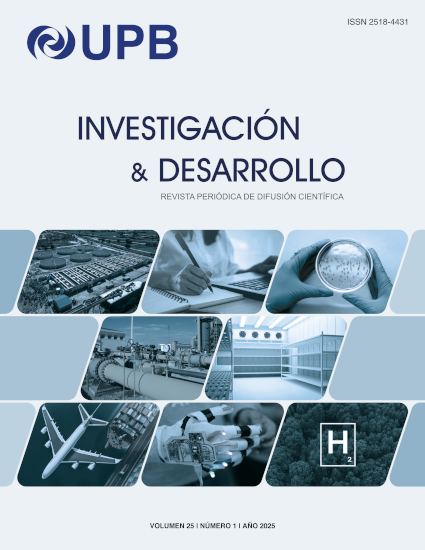MODELADO COMPUTACIONAL DE LA COMBUSTIÓN DE MEZCLAS DE HIDRÓGENO VERDE E HIDROCARBUROS PARA SU EVALUACIÓN ENERGÉTICA Y DE EMISIONES DE CO2
DOI:
https://doi.org/10.23881/idupbo.025.1-9iPalabras clave:
Hidrogeno verde, Combustión, Evaluación energética, Emisiones de CO2Resumen
Bolivia, al igual que otros países en desarrollo, enfrenta el reto de reducir su dependencia de combustibles fósiles y avanzar hacia una matriz energética más limpia. En este contexto, el hidrógeno verde surge como una alternativa viable, aunque su implementación aún requiere investigación local. Países como Chile ya han dado pasos importantes mediante políticas como la Estrategia Nacional del Hidrógeno Verde, que promueve su uso en diversas aplicaciones, incluyendo la combustión. Este trabajo se enmarca en esa línea de desarrollo, presentando el modelado computacional de la combustión de mezclas de hidrógeno verde con cuatro hidrocarburos: metano, gas licuado de petróleo (GLP), octano y etanol. Para esto, se desarrolla un código en Python para estimar propiedades fisicoquímicas a lo largo del rango de mezclas, las cuales se integran en simulaciones termodinámicas en OpenModelica, utilizando la biblioteca ThermoSysPro. Posteriormente, los resultados son procesados mediante otro código en Python, permitiendo analizar fracciones másicas de productos de combustión en condiciones estequiométricas con exceso de 10% de aire, el grado de descarbonización en función de la fracción y flujo másico de hidrógeno, la energía generada con y sin considerar pérdidas térmicas, los poderes caloríficos superior e inferior (PCS y PCI), y el índice de Wobbe en los casos de metano y GLP. Los resultados muestran que la descarbonización depende directamente del contenido de carbono del hidrocarburo base, y que la adición de hidrógeno incrementa la energía generada por unidad de masa, reforzando su potencial como vector energético en la transición hacia sistemas más sostenibles.Descargas
Referencias
[1] M. Gallardo and R. Barra, “Cambio climático global,” Universidad de Centro de Concepción, 1997.
[2] ACCIONA, “El hidrógeno verde: La energía del futuro clave en la descarbonización.” [Online]. Available: https://www.acciona.com/es/hidrogeno-verde.
[3] Z. Al-Hamamre and J. Yamin, “The effect of hydrogen addition on premixed laminar acetylene-hydrogen-air and ethanol-hydrogen-air flames,” Int J Hydrogen Energy, vol. 38, no. 18, pp. 7499–7509, Jun. 2013, doi: 10.1016/j.ijhydene.2013.03.125.
[4] M. K. G. Gheshlaghi and A. M. Tahsini, “Numerical investigation of hydrogen addition effects to a methane-fueled high-pressure combustion chamber,” Int J Hydrogen Energy, vol. 48, no. 86, pp. 33732–33745, 2023, doi: 10.1016/j.ijhydene.2023.05.119.
[5] H. Ishaq and I. Dincer, “A comprehensive study on using new hydrogen-natural gas and ammonia-natural gas blends for better performance,” J Nat Gas Sci Eng, vol. 81, 2020, doi: 10.1016/j.jngse.2020.103362.
[6] B. Breer et al., “Numerical investigation of NOx production from premixed hydrogen/methane fuel blends,” Combust Flame, vol. 255, 2023, doi: 10.1016/j.combustflame.2023.112920
[7] G. Ali, T. Zhang, W. Wu, and Y. Zhou, “Effect of hydrogen addition on NOx formation mechanism and pathways in MILD combustion of H2-rich low calorific value fuels,” Int J Hydrogen Energy, vol. 45, no. 15, pp. 9200–9210, 2020, doi: 10.1016/j.ijhydene.2020.01.027.
[8] M. N. Rahman, N. Shahril, S. Yusup, and I. Shariff, “Hydrogen Co-Firing Characteristics in a Single Swirl Burner: A Numerical Analysis,” IOP Conf Ser Mater Sci Eng, vol. 1257, no. 1, p. 012020, Oct. 2022, doi: 10.1088/1757-899x/1257/1/012020.
[9] K. Bayramoğlu, A. Bahlekeh and K. Masera, “Numerical investigation of the hydrogen, ammonia and methane fuel blends on the combustion emissions and performance,” Int J Hydrogen Energy, vol. 48, no. 99, pp. 39586–39598, 2023, doi: 10.1016/j.ijhydene.2023.06.079.
[10] H. Rashid, Q. Zhu, M. Rauf, and A. Oppong, “Towards cleaner combustion of hydrocarbons by blending with ammonia and hydrogen using CFD-Based emissions minimization,” Results in Engineering, vol. 27, 2025, doi: 10.1016/j.rineng.2025.105604.
[11] B. Wang, C. Yang, H. Wang, D. Hu, B. Duan, and Y. Wang, “Study on Combustion and Emission Performance of Dual Injection Strategy for Ammonia/Hydrogen Dual-Fuel Engine,” in Journal of Physics: Conference Series, 2023. doi: 10.1088/1742-6596/2437/1/012027.
[12] G. Wobbe, “La definizione della qualità del gas,” L’industria del gas e degli acquedotti, vol. XV, no. 11, pp. 165–172, Rome, Italy, 1926.
[13] A. Cicchitti, C. Lombardi, and M. Silvestri, “Two-phase cooling experiments: pressure drop, heat transfer and burnout measurements,” Energ. Nucl., vol. 7, pp. 417–425, 1960, [Online]. Available: http://www.osti.gov/energycitations/product.biblio.jsp?osti_id=4181977.
[14] Y. A. Cengel, and M. A. Boles, Thermodynamics: An engineering approach, 8va Edición. México, 2015.
[15] H. Copete, A. Amell, and F. Cadavid, “Simulación numérica de una cámara de combustión de alta velocidad con dos configuraciones de inyección de combustible,” Dyna, vol. 75, no. 156, pp. 109–120, 2008.
[16] CoolProp Development Team, "CoolProp", version 6.6.0, 2024. [Online]. Available: https://coolprop.org .
Descargas
Archivos adicionales
Publicado
Número
Sección
Licencia
Derechos de autor 2025 Matías Andrés Carrión-Salazar, Daniel Felipe Sempértegui-Tapia, Cristian Chávez-Toro

Esta obra está bajo una licencia internacional Creative Commons Atribución-NoComercial-CompartirIgual 4.0.
Reconocimiento-NoComercial-CompartirIgual
CC BY-NC-SA
Esta licencia permite a otros entremezclar, ajustar y construir a partir de su obra con fines no comerciales, siempre y cuando le reconozcan la autoría y sus nuevas creaciones estén bajo una licencia con los mismos términos.
Los autores pueden realizar acuerdos contractuales adicionales separados para la distribución no exclusiva de la versión publicada del artículo publicado en la revista (por ejemplo, publicarlo en un repositorio institucional o en un libro), sujeto a un reconocimiento de su publicación inicial en esta revista
